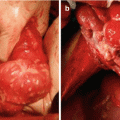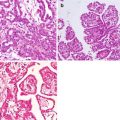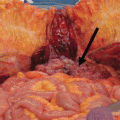© Springer International Publishing AG 2017
Emel Canbay (ed.)Unusual Cases in Peritoneal Surface Malignancies 10.1007/978-3-319-51523-6_88. The Role of Surgery and Tyrosine Kinase Inhibitors in the Management of Advanced or Recurrent GIST
(1)
Surgical Oncology, Wake Forest Baptist Health, Winston-Salem, NC, USA
(2)
Surgical Oncology, Wake Forest University, Medical Center Blvd, Winston-Salem, North Carolina 27157, USA
8.1 Introduction
Gastrointestinal stromal tumors (GISTs) are the most common gastrointestinal sarcoma, accounting for 5% of all mesenchymal tumors and 1–3% of all gastrointestinal tumors. The annual incidence is 10–13 per 1,000,000, with the majority arising in the stomach (50–60%) and small bowel (20–30%) and only a minority in the large bowel (5%) and esophagus (<5%) [1, 2]. GISTs arise from activating mutations of tyrosine kinase receptors, most commonly by KIT (CD117) which is expressed in 95% of GISTs or platelet-derived growth factor receptor (PDGFR) which is mutated in 5–10% of GISTs. Yet, 10–15% have no known mutation in KIT or PDGRF and are wild type. The treatment of GISTs has dramatically changed since 2002 due to the FDA approval of imatinib/Gleevec, a tyrosine kinase inhibitor (TKI) of c-KIT. Imatinib has initial response rates of 75–80% [3].
For localized disease, complete resection is the primary treatment and only chance of cure [1, 4]. Although complete resection is possible in 85% of patients, 40% recur within 18–24 months after complete resection [5–7]. Risk of recurrence is associated with increased mitotic rates (>5/50HPFs), tumor size, tumor perforation, and small bowel location [8]. Adjuvant imatinib is recommended for patients with high or intermediate risk.
Metastatic disease occurs in 15–47% of patients and most commonly in the liver, peritoneum, and omentum and only rarely in lymph nodes. Extra-abdominal metastasis including the lungs or bone represents advanced disease. In advanced disease that is either unresectable or metastatic, imatinib has significantly improved progression-free survival (PFS) and overall survival (OS). TKIs are the primary treatment of metastatic GISTs. Prior to imatinib, median survival was 10–20 months with a 5-year survival of less than 10%. Imatinib has allowed for median OS of 50–60 months and a 5-year OS of approximately 50% [9].
8.2 Role of Surgery in Metastatic Disease
In selected patients with limited metastatic disease, resection of isolated peritoneal and liver metastasis has shown benefit [10–13]. The National Comprehensive Cancer Network (NCCN) recommends resection in cases of limited disease progression, locally advanced disease, or previously unresectable tumors following a favorable response to treatment. Optimal timing of resection has been disputed in the setting of metastatic disease. There are two strategies that have been recommended. The first, proposed by Haller et al., is to treat with TKI and reserve for surgery until there are signs of resistance [14]. The second strategy employs surgery at least 6 months after the initiation of TKI therapy to maximize the period of responsiveness to TKI and prior to the appearance of resistant disease. This strategy has been employed by DeMatteo et al. from Memorial Sloan Kettering [15]. A multi-institutional study between Duke, Pittsburg, and Johns Hopkins of 39 patients that underwent hepatectomy for metastatic GISTs also supports this approach. In this study, 59% received preoperative TKI, and median duration of imatinib was 18 months. Patients who had >18 months of preoperative TKI had poorer DFS and OS [12]. Receipt of postoperative TKI therapy was associated with significantly improved survival.
Current literature supports resection of responsive disease after 6 months, but prior to 2 years. Waiting at least 6 months has been recommended to allow for maximal response, which typically occurs 6–9 months after initiation of imatinib, and to allow for determination of response to therapy. The response to TKI has significant prognostic value, as patients with disease progression on a TKI will have poor outcomes despite complete resection. At baseline, nearly 14% of patients have primary resistance, and half of patients develop secondary resistance by 2 years. It is therefore also recommended that patients undergo resection by 2 years to avoid resistant clone proliferation. Additionally, patients should resume TKI therapy as early as possible postoperatively, essentially once the patient is able to tolerate oral intake.
8.3 Cytoreductive Surgery (CS)
8.3.1 Pre-imatinib Era
Prior to TKI/imatinib therapy, response rates to standard chemotherapy were extremely low, less than 10%. Complete macroscopic resection (R0/R1) of GISTs was the only chance of obtaining improved survival and cure [16–18]. DeMatteo et al. studied 127 patients from 1983–2002 that underwent complete (R0/R1) resection of primary GISTs [19]. RFS at 1 and 5 years was 83% and 63%, respectively. This Memorial Sloan Kettering Cancer Center (MSKCC) group found the following risk factors for recurrence: ≥5 mitoses/50 high-power fields, tumor size ≥10 cm, and small bowel primary tumor. They also determined that specific KIT mutations had prognostic importance: (1) KIT exon 11 point mutations and insertions had a favorable prognosis, (2) KIT exon 9 mutations and KIT exon 11 deletions had a higher rate of recurrence, and (3) patients without tyrosine kinase mutations had intermediate outcome.
Gold et al. studied 199 patients with metastatic GISTs prior to the use of imatinib [20]. In this retrospective study, 68% of patients with metastatic disease underwent resection with improved overall survival compared to the 42% that underwent conventional chemotherapy only. Median survival for the entire cohort was 19 months, 2-year survival was 41%, and 5-year survival was 25%. In contrast, after imatinib treatment, median survival was extended to 58 months and 2-year survival rates to 72%.
8.3.2 Post-imatinib Era
8.3.2.1 Adjuvant Treatment
Studies of adjuvant imatinib therapy demonstrate decreased risk of recurrence. Duration of adjuvant treatment has been extended from 1 year to 3–5 years for patients with high-risk features. One of the first trials to test adjuvant imatinib was ACOSOG Z9000, which administered imatinib at a dose of 400 mg daily for 12 months to 106 patients [21]. This trial found factors associated with decreased RFS including increasing tumor size, small bowel origin, mitotic rate, age, and KIT exon 9 mutations. ACOSOG Z9001, a phase III double-blinded study, randomized patients with primary localized GISTs to 1 year of postoperative imatinib therapy in 317 patients versus placebo in 328 patients [22]. This study was closed early due to the significantly fewer recurrence events in the imatinib arm. In this study, RFS was improved by imatinib therapy 98% vs 83% in favor of imatinib (HR 0.35, 95% CI, 0.22–0.53). In addition, this study also found that patients with exon 11 deletions had longer RFS on imatinib. The Scandinavian Sarcoma Group (SSGXVIII/AIO) trial compared imatinib therapy at 400 mg daily for 1 year versus 3 years and found that 3 years of therapy was associated with improved RFS and OS in high-risk GISTs, as well as patients with exon 11 mutations [23].
8.3.2.2 Neoadjuvant Treatment
Andtbacka et al. in a retrospective review of 46 patients that were treated with neoadjuvant imatinib at a dose of 400 mg daily found that imatinib decreased tumor size and was associated with complete resection [10]. This study included 11 patients with primary GISTs and 35 patients with recurrent or metastatic GISTs. All primary GIST patients underwent complete resection, whereas only 11 of the 35 patients with recurrent/metastatic GISTs underwent complete resection. Patients with PR had higher R0/R1 resection rates. The RTOG 0132/ACRIN 6665, a phase II trial of neoadjuvant imatinib followed by 2 years of adjuvant imatinib, prospectively studied 30 patients with resectable primary GISTs and 22 patients with potentially resectable recurrent or metastatic disease [24]. The authors found 7% PR, 83% SD, 83% PFS, and 93% 2-year OS in patients with primary resectable disease versus 4.5% PR, 91% SD, 77% PFS, and 91% 2-year OS in patients with recurrent/metastatic GISTs. This study was limited to only patients that responded to therapy. The median duration of preoperative imatinib in the recurrent/metastatic group was 2.1 months, which is potentially shorter than that needed to achieve maximal response.
8.3.2.3 Neoadjuvant Therapy for Locally Advanced, Recurrent, and Metastatic Disease
Studies of TKIs in the neoadjuvant setting for metastatic disease are limited and support surgery for limited metastatic disease, disease that demonstrates response to TKI therapy, and disease that can be completely resected [10, 15, 25–28].
- 1.
Bauer et al. reported their European multi-institutional study of preoperative imatinib in 239 patients with metastatic disease [25]. In this study, median duration of preoperative imatinib therapy was 1.1 years, and an R0/R1 was performed in 74% of patients. Patients who had a complete resection had an 8.7-year OS vs 5.3-year OS in patients that had an R2 resection (P = 0.0001). PFS in patients with an R2 resection was 1.9 year and had not been reached in R0/R1. The authors conclude that survival benefit can be achieved for metastasectomy if completely resected.
- 2.
Raut et al. reported on a single institutional study of 69 patients with advanced GISTs and their responsiveness to preoperative TKI [28]. R0/R1 was performed in 78% with SD, 25% with limited disease progression (LDP), and 7% in generalized disease progression (GDP). Response to therapy was related to both PFS and OS at 12 months. PFS for SD, LDP, and GDP was 80%, 33%, and 0%, respectively (P < 0.001). OS was 95%, 86%, and 0% for SD, LDP, and GDP, respectively (P < 0.001). The authors conclude that cytoreductive surgery has a limited role in patients demonstrating disease progression while on TKI.
- 3.
Gronchi et al. reported a single institution experience from Milan of 37 patients with advanced/metastatic GIST that underwent surgery after imatinib [27]. The authors found that DSS at 12 months was 100% for patients responding to imatinib, whereas DSS was 60% for patients progressing on imatinib. The authors conclude that patients progressing on imatinib do not have major benefit from surgery.
- 4.
DeMatteo et al. reported on 40 patients with metastatic GISTs treated with a median of 15 months of preoperative TKI therapy [15]. Response to therapy was graded as responsive disease, focal resistance (one tumor growing), or multifocal resistance (more than one tumor growing). Overall survival at 2 years for responsive disease was 100%, focal resistance was 61%, and multifocal resistance was 31%. PFS of responsive was 61% at 2 years, focal resistant disease progressed at a median of 12 months, and multifocal resistant disease progressed at a median of 3 months. The authors conclude that patients with metastatic GIST that have responsive disease or focal resistance to TKI can benefit from resection; however, patients with multifocal resistance do not have significant benefit from resection.
Stay updated, free articles. Join our Telegram channel

Full access? Get Clinical Tree






